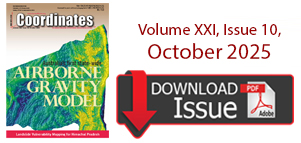| Industry | |
Industry
Pix4D extends drone-based imagery with machine learning techniques
Pix4D has introduced a new image classification technique as part of its Pix4Dmapper photogrammetry software. The solution uses new machine vision techniques for photogrammetry for automatically classification of drone-based point clouds.
While Pix4D software is mostly known for photogrammetry from drone-captured imagery, one of its latest mapping innovations is a software feature that automatically classifies drone-based point clouds, based on machine learning techniques. By using this feature, entire 3D point clouds are classified into individual groupings, divided into categories such as buildings, roads or vegetation.
Global UAV’s survey division obtains night flight authorization
Global UAV Technologies Ltd. has announced that its survey division, Pioneer Aerial Surveys has received authorization from Transport Canada to conduct night UAV operations in every jurisdiction across Canada except Quebec, where the application is currently still being processed. The night operations are significant to Pioneer Aerial, as the geophysical survey services will not be affected by shorter daylight hours during the winter months in Canada. Pioneer Aerial is working throughout Canada during the winter as this division of Global UAV continues to grow. www.globaluavtech.com
Esri India rolls out ‘GeoInnovation’
Esri India has announced GeoInnovation – A Challenge for Startupreneurs, in partnership with Department of Science and Technology (DST), Ministry of Science. It is an exciting program for entrepreneurs who are building GIS technology-enabled start-ups. The aim of the challenge is to provide the start-ups with a platform to showcase their GIS-based business ideas and build a strong network of industry experts, investors and peer group.
Aireon deployment passes midway point
Aireon have successfully launched and deployment its space-based Automatic Dependent Surveillance-Broadcast (ADS-B) payloads hosted onboard the Iridium® NEXT satellite constellation. Prior to the deployment of these 10 payloads, the Aireon system was already receiving approximately 6 billion position reports per month. The position reports produced by the system have also received additional validation testing from several successful test flights with both the Federal Aviation Administration (FAA) and NAV CANADA.
The Aireon service is hosted by the Iridium NEXT satellite constellation, which will consist of 66 low-earth orbit interconnected satellites. A total of 81 Iridium NEXT satellites are being built, all of which will have the Aireon payload onboard. Currently, 75 satellites are planned to be deployed with nine serving as on-orbit spares and the remaining six as ground spares. The constellation is planned for completion in mid-2018. www.aireon.com
Telenav launches embedded navigation
Telenav has announced that European automotive manufacturers Opel/Vauxhall’s new infotainment system, Navi 4.0 IntelliLink, now includes Telenav’s integrated navigation system. The Telenav navigation system is available in various Opel/Vauxhall models, including ADAM/VIVA, Corsa, KARL, and Zafira. The Telenav navigation system features provide a highly dynamic, relevant, useful and personalized experience for users. www.telenav.com
GPS III satellite receives commands from OCX ground control segment
The first advanced GPS III satellite successfully established remote connectivity and communicated with the Next Generation Operational Control System (OCX), further validating the U.S. Air Force’s modernized GPS is ready to launch its first satellite. GPS III’s new L1C civil signal also will make it the first GPS satellite to be interoperable with other international global navigation satellite systems, like Galileo.
OCX will revolutionize GPS command and control and mission management capabilities. It will control all legacy and new signals, provide protection against evolving cyber threats, and reduce operation and sustainment costs through efficient software architecture, automation and performance-based logistics. OCX represents a quantum leap in capabilities over the current system, providing flexibility and adaptability to meet future GPS mission needs. www.lockheedmartin.com/gps.
NovAtel joins Baidu’s Apollo autonomous driving ecosystem
NovAtel and its line of NovAtel SPAN GNSS+INS products designed to provide position, orientation and time as a critical component of autonomous solutions, has joined Baidu’s Apollo Autonomous Driving ecosystem – Project Apollo.
Project Apollo has been initiated to provide an open, comprehensive and reliable software platform for Baidu’s partners in the automotive and autonomous driving industries. Baidu Inc., the owner of China’s largest search engine, announced back in 2015 that the company planned to release an autonomous vehicle that year. Since that time, Project Apollo has expanded and several partnerships have helped grow technological advances.
Swift navigation and carnegie robotics now shipping Duro
Swift Navigation and Carnegie Robotics LLC (CRL) have announced immediate availability of Duro™, an extremely rugged, low-cost, centimeteraccurate, dual-frequency RTK GNSS receiver in an easily-deployable enclosure. Swift Navigation teamed with Pittsburgh-based CRL to develop Duro, which is a ruggedized, enclosed version of Swift Navigation’s flagship Piksi® Multi dual-frequency RTK GNSS receiver. www.swiftnav.com
Antenova’s latest compact antenna boosts GNSS signals from difficult locations
Antenova Ltd, manufacturer of antennas and RF antenna modules, is launching a brand new compact, all-in-one active GNSS antenna, part number M20047-1. It operates in the 1559-1609 MHz bands, and offers designers a useful, spacesaving option for small tracking devices.
It’s key features are the active components, the built-in LNA and filter, which act to boost the signal to the GNSS processor in environments where there is a restricted view of the sky and line-of-sight to the horizon is difficult. With the LNA and filtering already built into the antenna, designers will not need to add them, and can save space on their PCB.












 (No Ratings Yet)
(No Ratings Yet)






Leave your response!